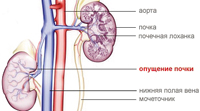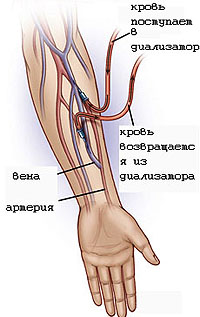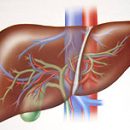Nephroptosis - the disease is not rare. According to statistics, people with «walking» kidney in the modern world becomes more and more. What causes? In bad ecology? In improper nutrition? No. In mistakes of doctors.
Content
Disappointment in the operational treatment of nephropotosis, the unsuccessful results of which were still recently observed quite often, were associated with a lack of clear indications for it, the wrong choice of the method of fixing the kidney, the lack of information about changes in the kidney vessels and, consequently, the complications of this disease. Recent years are characterized by increased interest in nephroptosis as the cause of pyelonephritis, arterial hypertension and hematuria.
Studies of recent years related to the development of vasograph (X-ray study of blood and lymphatic kidney vessels) made it possible to establish significant changes in the kidney in nephroptosis, which cause severe functional and morphological disorders leading to serious complications.

Part of the patients have already been transferred in the past operation - nephropsychia. Before the operation, they did not produce a vasographic study and, as it turned out after its execution, a dystoped kidney was detected. Unnecessary tension of the renal leg led heavy hemo- and urodynamic disorders in the kidney.
As a result of the identified diagnostic errors of patients, it was necessary to repeated operational intervention. 2 of them produced nephrectomy due to kidney wrinkling, and 2 dystoped kidney is installed in physiological position.
With the tumor of the kidney due to gravity, the book is shifted and when it is tackling it is mistaken, you can take for omitted. This error is more often allowed when examining a patient in polyclinical conditions, when a radiographic study does not produce or limited to the overview radiography. Less often error is observed in the hospital if the survey does not fully or incorrectly elect the research method. The confirmation of this fact is the identification of 3 patients with a tumor of the kidney, in which a long time was diagnosed with nephroplation.
The shift of the kidney down by force, in addition to the tumor, can cause other pathological processes, accompanied by an increase in the size of the organ and initially erroneously adopted for nephroptosis, hydronephrosis, or pressure on neighboring organs.
To avoid diagnostic and tactical errors to all patients with nephroptosis, we are very advisable - along with an excretory urography in the horizontal and vertical position to produce the necessary vasographic research. Because only after that it is possible to determine the testimony for surgical treatment and correctly schedule the amount of operation (it will be nephropsychia, the correction of vessels or others).
In determining the need for operational treatment of nephropolosis, it is also necessary to evaluate the results of arteriological and occult, as indications of the operation are not so many kidney mobility, how much manifestation of this disease, its complications, the nature and degree of vascular disorders in the kidney. In the presence of signs of impaired venous outflow from the kidneys (twisted veins, scar battles in the area of its imposition in a hollow vein, intraongen varicose veins) of neoppecia must precede the revision of the vascular leg.
Studies have proven that diagnostic and tactical errors, alas are not uncommon in medical practice, and they arise mainly due to the absence of oncological alertness, improper choice of the method of radiological research or non-fulfillment of its volume, including vasograph.









